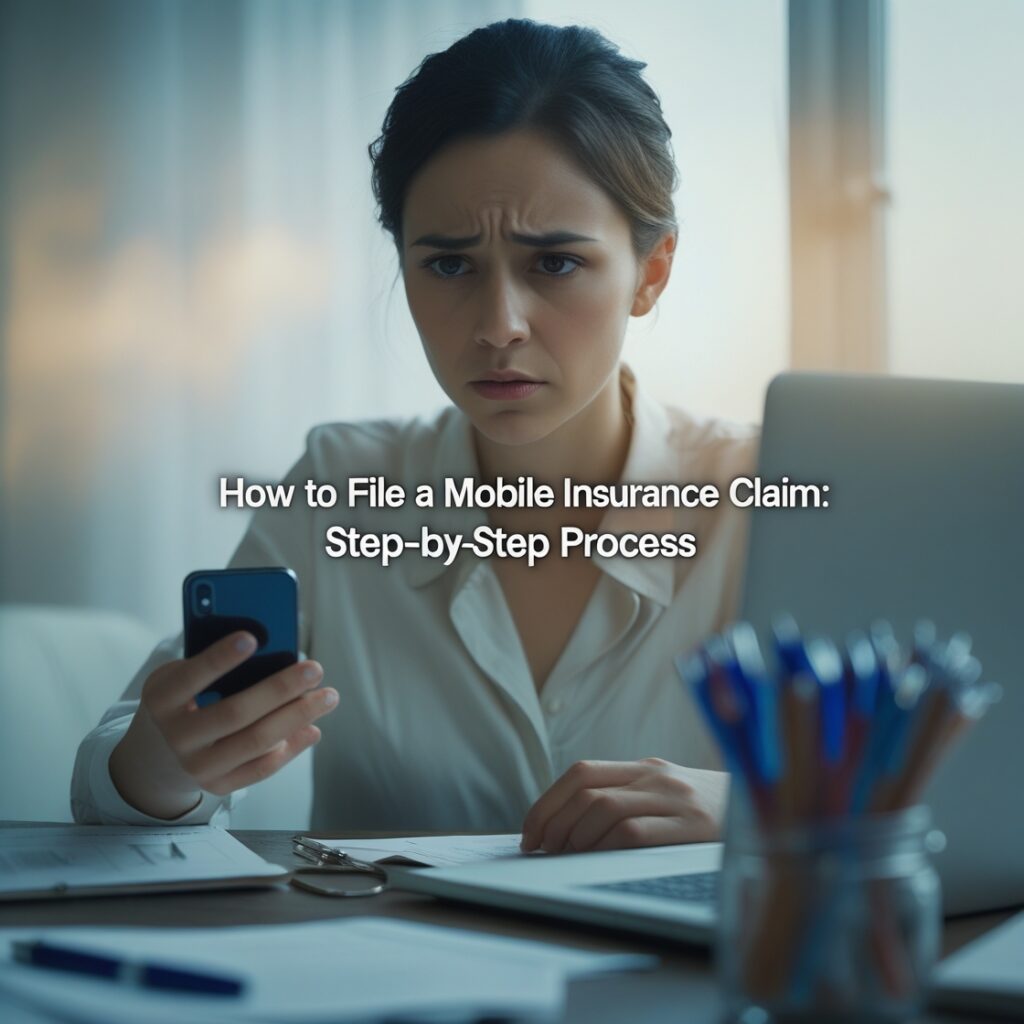How to File a Mobile Insurance Claim: Step-by-Step Process 2025?

In today’s fast-paced digital world, smartphones are more than just communication tools—they are essential companions in our daily lives. From online banking and social networking to business communication and entertainment, our smartphones handle it all. With such dependence on our devices, the loss, theft, or damage of a smartphone can be not only emotionally distressing but also financially burdensome.
This is where mobile insurance comes into play. It provides financial protection against accidental damage, theft, and sometimes even liquid damage or mechanical breakdowns. But having insurance isn’t enough—you also need to understand how to file a claim correctly and efficiently to benefit from your policy.
In this article, we will walk you through a step-by-step guide on how to file a mobile insurance claim, what documents are required, common mistakes to avoid, and tips to ensure a smooth claims process.

What Is a Mobile Insurance Claim?
A mobile insurance claim is a formal request made by the policyholder to the insurance provider for compensation or service (like repair or replacement) after the insured mobile phone suffers an accidental loss, damage, theft, or malfunction covered under the policy.
Filing a claim involves reporting the incident to your insurer, providing the required documentation, and following their procedure to get reimbursement or device replacement/repair.
When Can You File a Mobile Insurance Claim?
You can usually file a claim for incidents such as:
- Accidental damage (like cracked screens or dropped phones)
- Theft or loss
- Liquid damage (if included in the policy)
- Mechanical or electrical breakdown beyond the manufacturer’s warranty
- Fire or explosion damage
- Damage caused during travel
Each insurance provider has different terms, so it’s important to carefully read your policy to know what’s covered and what isn’t.
Step-by-Step Process to File a Mobile Insurance Claim
Let’s walk through the step-by-step process for filing a mobile insurance claim:

Step 1: Review Your Insurance Policy
Before taking any action, go through your insurance policy documents or app dashboard (if insured online). Pay attention to:
- Coverage details (what is and isn’t covered)
- Claim eligibility period (some insurers require claims to be filed within 24-48 hours)
- Claim limits (how many claims you can make per year)
- Required documents
Knowing your coverage will help you understand whether your current situation qualifies for a claim.
Step 2: Report the Incident Immediately
Most insurance providers require that you report the incident within a specific time frame, usually within 24 to 48 hours. Failing to report it on time may lead to claim rejection.
- For theft: File an FIR (First Information Report) at the nearest police station.
- For loss in transit: File a report with the transportation authority or courier service.
- For damage: Take photos of the damaged device and note the time and nature of the incident.
Step 3: Inform Your Insurance Provider
Contact your insurance provider’s customer care through any of the following methods:
- Phone call
- Mobile app
- Insurance company’s website
When contacting them, be ready with:
- Your policy number or registered mobile number
- Device IMEI number
- Details of the incident (what happened, when, where, how)
They will create a claim reference number and guide you on the next steps.

Step 4: Submit the Required Documents
To support your claim, you’ll need to provide certain documents, which may include:
For Accidental Damage:
- Claim form (downloaded from the insurer’s site or mobile app)
- Copy of the original purchase invoice
- Photographs of the damaged device
- Government ID proof
- IMEI number
- Inspection report (if required)
For Theft/Loss:
- FIR copy (mandatory)
- Unblocking certificate from the mobile network provider
- Invoice of the phone
- Policy certificate
- Claim form
- KYC documents (ID proof, address proof)
Always double-check the list of documents required by your specific insurer, as it may vary.
Step 5: Submit the Device (If Applicable)
In case of physical damage, the insurer might require you to submit your damaged phone to:
- An authorized service center, or
- A designated courier pickup (if the insurer offers door-to-door service)
Some insurers inspect the phone before approving the claim to assess the extent of the damage and ensure it aligns with the reported incident.
Step 6: Claim Assessment and Verification
Once your documents and/or device are submitted, the insurer will review your claim.
They typically:
- Verify the cause of the damage/loss
- Ensure all documents are in order
- Cross-check whether the event is covered under your policy
This process can take anywhere from 3 to 7 working days, depending on the insurer and the complexity of the claim.
Step 7: Claim Approval or Rejection
After verification, the insurer will either:
- Approve the claim and initiate repair/replacement or payment
- Reject the claim if:
- The incident is not covered
- False information is provided
- Required documents are missing
You’ll be notified via email, SMS, or app notification. If approved, you’ll be given the details about how the replacement or reimbursement will be handled.
Step 8: Pay Deductible (If Applicable)
Many mobile insurance policies include a deductible—a fixed amount you have to pay before the insurer covers the rest.
Example:
If your phone repair costs ₹10,000 and the deductible is ₹2,000, the insurer will pay ₹8,000.
Always confirm the deductible mentioned in your policy and be prepared to pay it at the time of repair or replacement.
Step 9: Receive Replacement or Repaired Device
Once your claim is approved and deductible (if any) is paid:
- The insurer may send you a replacement device (either new or refurbished), or
- Repair your existing phone and return it to you
The total turnaround time is usually 7 to 15 business days, though it can vary based on parts availability or courier delays.
Tips for a Smooth Mobile Insurance Claim
To avoid delays or rejection of your claim, follow these useful tips:
- Read the policy thoroughly before filing the claim.
- Always keep your purchase invoice and insurance documents safe.
- File the claim within the required time limit (usually 24–48 hours).
- Avoid providing false information or exaggerated damage reports.
- Take clear pictures of the damage and document the incident well.
- Keep your device’s IMEI number noted down somewhere secure.
- Back up your data before submitting your phone for repair or replacement.

Common Reasons for Claim Rejection
Insurers may reject claims for several reasons, including:
- Delay in reporting the incident
- Filing for uncovered events (e.g., intentional damage)
- Claiming during the waiting period (usually the first 15 days after buying insurance)
- Providing false or incomplete information
- Missing documents
- Untraceable theft (no FIR or valid proof)
Understanding these common pitfalls can help you avoid them.
Mobile Insurance Claim Example
Let’s say you drop your phone accidentally, and the screen cracks. Here’s a quick look at how the process might work:
- Incident: Your phone falls and the screen cracks.
- Step 1: You check your insurance policy to confirm screen damage is covered.
- Step 2: You contact your insurer within 24 hours.
- Step 3: You fill out a claim form and submit documents (invoice, ID proof, photos of damage).
- Step 4: You send your phone to an authorized service center.
- Step 5: Insurer inspects and approves the claim.
- Step 6: You pay the ₹1,000 deductible.
- Step 7: Your repaired phone is delivered back in 7 days.
Conclusion
Filing a mobile insurance claim doesn’t have to be overwhelming or complicated. By understanding the process, knowing your policy coverage, and submitting the right documentation on time, you can smoothly navigate the system and get your phone repaired or replaced with minimal hassle.
Smartphones are expensive investments, and mobile insurance offers a practical way to protect them. But the true value of insurance comes only when you can file and successfully claim benefits without delays. So, stay informed, organized, and proactive to make the most of your mobile insurance coverage.
















